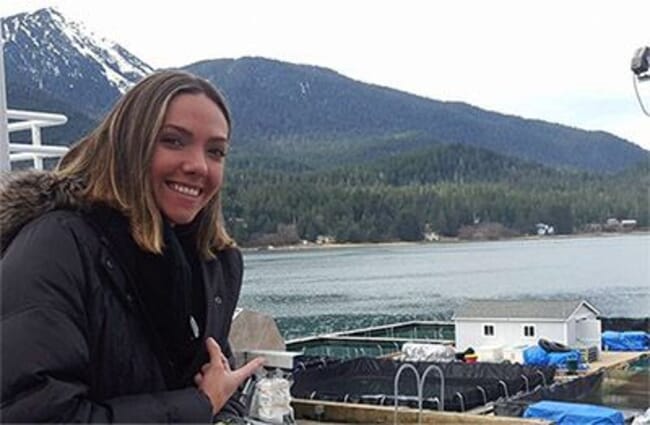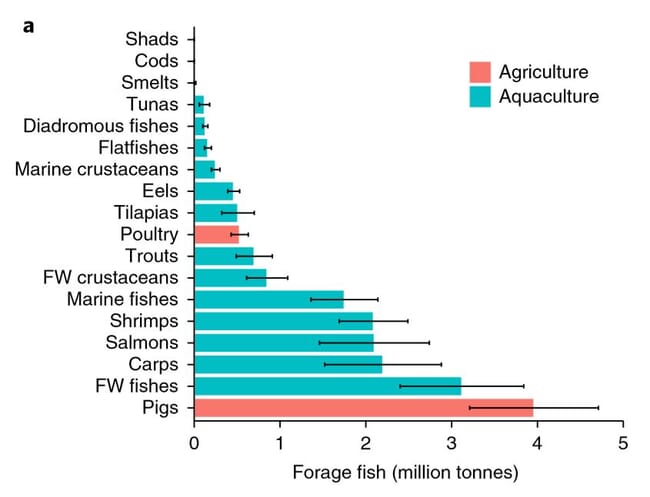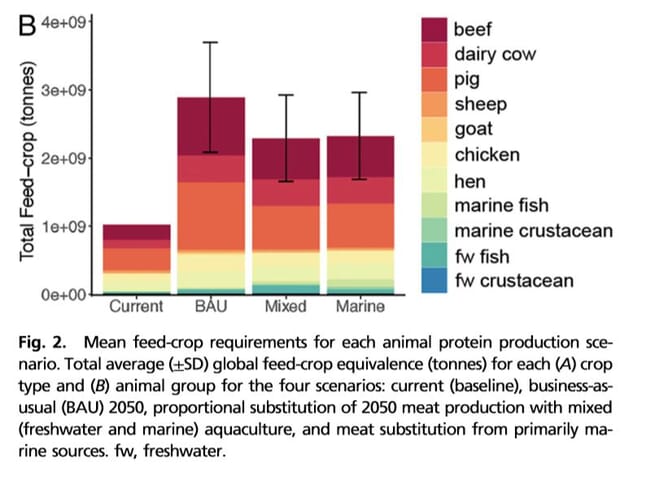Finding suitable ingredients to replace the finite marine resources commonly used in aquaculture feeds has been challenging the sector for decades.

Recently, a growing global population, increased seafood consumption per capita and the impacts of climate change on global food systems have combined to shed light on the need for further development of aquafeeds that contain fewer ingredients from wild fisheries.
The FAO estimates that an additional 27 million tonnes of seafood production will be needed to maintain the present level of consumption by 2030. With global production of fishmeal and fish oil remaining relatively unchanged over the last 30 years, the development and use of alternative ingredients to produce enough feed for aquaculture (and agriculture) will need to increase as well. However, the use of alternative ingredients – such as microalgae products, fisheries byproducts or genetically modified crops – comes with its own set of challenges.
Enter Dr Halley Froehlich – a post-doctoral researcher (soon to be assistant professor) at the National Center for Ecological Analysis and Synthesis (NCEAS) at UC Santa Barbara in California. Dr Froehlich and her colleagues at NCEAS and the Conservation Aquaculture Research Team (CART) have published a suite of research that addresses important issues for the future availability of raw materials for aquafeeds. Dr Froehlich’s research has brought up some of the glaring challenges facing the future of aquaculture as part of the global food system – the ways to sustainably exploit forage fish stocks despite increased aquaculture production1; how the increased use of terrestrial crops in aquafeeds will impact land use2; and the effects of climate change on aquaculture production3.

© Froehlich et al. 2018
In the first paper, Dr Froehlich compares the expected supply of forage fish as a feed ingredient in 2050 to different scenarios of projected animal protein production. In the second, Froehlich and her colleagues predict the land required to grow enough crops to feed terrestrial and aquatic animals. The two projects, Froehlich notes, “were done simultaneously very consciously because both of those aspects are happening at the same time, and we wanted to try to capture that”.
Dr Froehlich approached the research in a way “that would address these two complexities of aquaculture, and ultimately agriculture, because both systems are inherently linked”. One of the big connections between the future of aquaculture and agriculture, she says, is feed.
Her research shows that if feed production continues in the mode of “business as usual”, the amount of forage fish needed to supply the aquaculture and agriculture industries will far surpass ecological limits and maximum catch. This gap in supply might “call the aquaculture industry to action”, Froehlich says, because “the future is going to be limited”.
Animal production (aquatic and terrestrial) is expected to increase by 52 percent by 2050 to meet per-capita human consumption2, and this has implications for land use. Dr Froehlich found that, even if aquaculture provides over one third of animal-protein biomass, over 90 percent of feed crops would still be used for rearing terrestrial animals2. But when she modelled the increase in meat consumption as being entirely supplied by aquaculture, the scenario spared over 700 million hectares of land – an area twice the size of India2.

© Froehlich et al. 2018
Climate change
Of the three issues her research addresses, Dr Froehlich predicts that climate change will have the most impact. One reason for this is that wild fisheries’ landings and crop production can be severely impacted by changing conditions, which would have a trickle-down effect on feed supply.
When asked if she has seen the industry accounting for the potential future impacts of climate change, Dr Froehlich replied: “The simple answer is no. Explicit consideration of how climate change will affect, say, forage fish or access to certain crop-based ingredients, is not happening.”
The development of alternatives thus far has mostly been prompted by increases in the price of fishmeal and fish oil, rather than as an effort to safeguard against future uncertainties. That is something Dr Froehlich and her colleagues are starting to consider. “We want to understand how vulnerable these animals are, not just from the direct impacts on animals through temperature changes, but the downstream effects from ingredient access [as well].”
Research published in Nature on 28 January by the University of Tasmania’s Dr Richard Cottrell found that the major shocks to aquaculture systems over a time period of more than 50 years have been primarily due to mismanagement, disease and climate impacts4.
It’s not all doom and gloom, though. Dr Froehlich is confident that we’ll be able to produce enough seafood in the future without surpassing wild forage fish limits or putting pressure on terrestrial systems. “Seafood is the most highly traded food commodity in the world, which has resulted in access to resources that we otherwise wouldn’t have.” From her perspective, “taking on [these challenges] and thinking about how we could do it right, with oversight and standalone legislation that works with our fisheries and with our growth development plans” is the way forward.
Finding alternatives
Since the price of fishmeal and fish oil jumped in 2006, fish nutritionists have been working to develop feed formulations that allow for optimal growth while controlling costs and reducing reliance on limited marine resources5.
An issue that’s often overlooked is the scalability of novel ingredients and the feasibility and health implications of their inclusion in aquafeeds. “Not all feeds are created equal,” Dr Froehlich says. “You do end up losing efficiencies with certain levels of replacement.” What we don’t want, she argues , is to lose the nutritional value that seafood holds for consumers. Drs Froehlich and Cottrell are currently working on a meta-analysis to understand the implications of different feed ingredients as replacements for fishmeal and fish oil for multiple species.

© Froehlich et al. 2018
This concept – that finding “alternatives” to fishmeal and fish oil is not a simple task – is not new. The job of feed formulators is to create a blend of raw materials that can be turned into a feed that provides the animal with its specific nutritional requirements, while also producing something digestible and palatable to the animal, that holds its form in water and produces a product with nutritional value to consumers5.
In Dr Froehlich’s opinion, microalgae oils and proteins and an improved utilisation of fish by-products are very promising options as replacements for fishmeal and fish oil. In particular, Froehlich says, microalgae can be scaled up and “produced over short periods of time with relatively few resources”.
The effects of using various fishmeal and oil replacements in feed has been studied in great depth for several species, such as Atlantic salmon, giant tiger prawn, barramundi, whiteleg shrimp and tilapia. The huge range of species farmed in various conditions and systems, however, makes understanding the unique effects of each scenario very difficult to predict. “How we produce aquaculture matters,” Dr Froehlich says. “Marine aquaculture, for example, can produce a lot of food in a very small space, but it has its own risks if management is poor or oversight is weak.”
The limited nature of marine ingredients for aquafeeds, combined with the fact that more people around the world are eating more seafood than ever before, is driving industry investment to find suitable alternatives to fishmeal and fish oil. From a climate-based, ecological-impact perspective, farmed seafood is often a very sustainable option for consumers. Where the feed industry has room for improvement, however, is in understanding the scalability and functionality of ingredients that need to replace fishmeal and fish oil for each species of interest, so that the industry can sustainably grow to meet future demand.
Dr Froehlich will soon be working on developing her own lab as an assistant professor at UC Santa Barbara in California. She will also be at the upcoming F3 Challenge event in San Francisco in February. You can follow her work on Twitter: @DocFroehlich.
- 1. Froehlich, H., Jacobsen, N.S., Essington, T., Clavelle, T., Halpern, B. (2018) Avoiding the ecological limits of forage fish for fed aquaculture. Nature Sustainability, 1: 298-303
- 2. Froehlich, H., Rungea, C., Gentry, R., Steven D., Gaines, S., Halpern, B. (2018) Comparative terrestrial feed and land use of an aquaculture-dominant world. Proceedings of the National Academy of Sciences, 115 (20): 5295-5300
- 3. Froehlich, H., Gentry, R., Halpern, B. (2018) Global change in marine aquaculture production potential under climate change. Nature Ecology & Evolution, 2: 1745–1750
- 4. Cottrell, R. et al. (2019) Food production shocks across land and sea. Nature Sustainability
- 5. Turchini, G., Trushenski, J., Glencross, B.D. (2019) Thoughts for the Future of Aquaculture Nutrition: Realigning Perspectives to Reflect Contemporary Issues Related to Judicious Use of Marine Resources in Aquafeeds. North American Journal of Aquaculture 81:13–39

